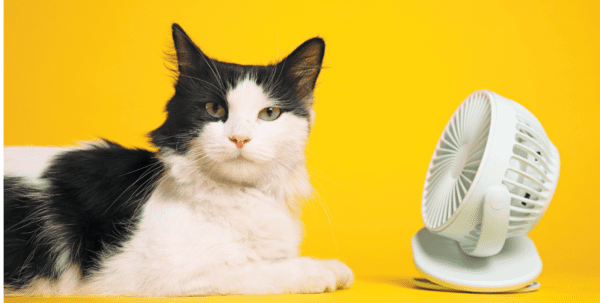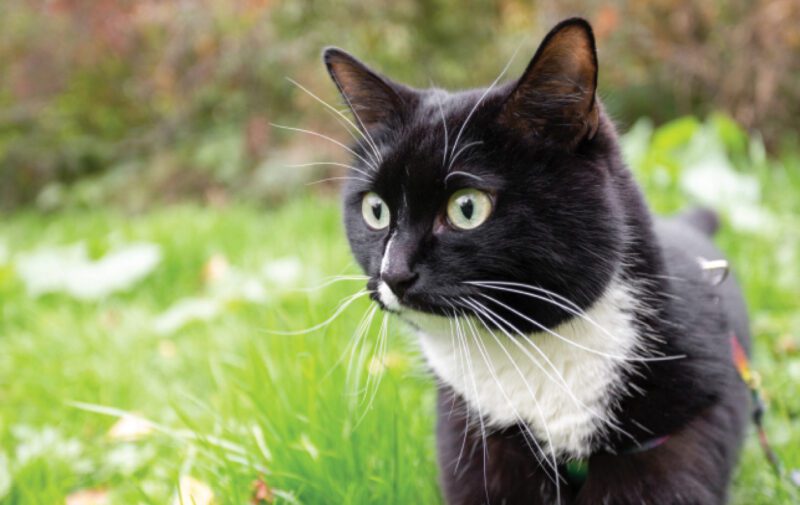Hot fun in the summertime sounds cool — but it can be dangerous, and that’s especially true for cats with outdoor privileges. While the topic of exclusively indoors vs. indoors/outdoors is about as divisive as today’s politics, there are some basic facts when it comes to cats’ summer safety.
Burning summer heat
Heatstroke is caused when the internal body temperature rises too much. While it’s more common in dogs, it’s an absolute fallacy to think that it hardly ever happens to cats because they rarely exert themselves in the heat. Cats are only able to sweat through their footpads. This is a very small area of the body, so it’s not a very effective cooling mechanism. To increase their ability to lose heat, they often lick themselves, applying saliva to their coat. The good news is that cats are pretty adept at finding their own cool spaces.
While dogs routinely pant to keep cool, panting in cats may be a sign of overheating. Other indications for concern are foaming at the mouth, drooling or even just an unwillingness to move — but it’s a cat, so often an unwillingness to move might be a daily occurrence. Just as when there is no air-conditioning, we appreciate fans — so do cats. Just make sure kitty can’t stick a paw into it.
Overweight or obese and geriatric cats are particularly susceptible to heatstroke, as are breeds with lots and lots of hair. Flat-face or brachycephalic cat breeds are particularly prone to heatstroke. Persian, Exotic Shorthair, Himalayan and Burmese breeds have shortened airways, which literally makes breathing difficult. In hot weather, these cats struggle.
Always ensure your cat has plenty of access to fresh water, although some cats might be hesitant to drink even when they’re hot. Put several bowls of water throughout the house or try a pet fountain to entice your cat to drink.

Preying animals
Coyotes rarely ring doorbells asking to be let inside to devour indoor cats. They usually wander into neighborhoods looking for easy food sources and, in the heat of the summer, water, making a cat easy prey.
Even catching a rat or mouse can have consequences. The cat may attack, but more formidable rodents can fight — and bite — back. Even if the rat loses the battle, the cat can lose, too, as a result of multiple bites, which can cause an infection or even disease transmission. Cats can also be poisoned by eating rodents that have ingested rat poison.
Climbing up a tree
Whether the cat scampers up a tree after a bird or a squirrel or just for fun, cats rarely plan in advance for the climb down. So, what do you do about those cats up a tree? Call the fire department? Unless you get Sarah, the Mayberry operator, you’ll likely hear a bemused operator ask, “You’re kidding, right?” Even if you are somehow able to convince emergency personnel to respond, there may be a fee. Barney Fife won’t rescue the cat.
The best advice: Be patient. Veterinary ER clinics rarely report treating cats who have fallen from trees. Emergency rooms do treat people who have fallen trying to rescue feline friends. Entice kitty with tuna, sardines or salmon at the base of the tree … wait for hunger to overcome fear.
Escaping through a window
Cats love viewing the world from a high vantage point, often looking out a window watching and batting at passing butterflies and birds. An unsecured screen window or no screen window can lead to a dive down many stories, which is called “high-rise syndrome.”
It’s possible for a cat to survive at a velocity of 60 miles per hour, according to a study published in the Journal of the American Veterinary Medical Association of 132 cats who fell an average of five-and-a-half stories. Of those cats followed in the study, 90% survived, albeit many required significant medical attention. That’s from five-and-a-half stories, but from 20 floors up, cats are unlikely to survive.
While cats do have an innate ability to acrobatically right themselves in midair, for most cats that’s a real challenge. Elderly cats often lose their ability to accomplish this athletic exploit, and overweight or obese cats have a difficult time physically righting themselves. According to the Association for Pet Obesity Prevention, that’s about 60% of all cats.
Even when cats are able to land on all fours there’s another problem: It’s called gravity. Landing on all fours can offer some protection, but broken legs and ribs aren’t uncommon. It’s true that as they fall, their legs stop the fall but their heads keep going and as their jaw slams to the ground, broken jaws are not uncommon.
Biting parasites & pests
With warmer weather, parasites flourish, and even indoor-only cats require protection. Many cats who caretakers call indoors-only do have access to backyards or catios outside. While you may be able to keep foxes or coyotes away, keeping parasites at bay requires protection suggested by a veterinary professional. Even in a high-rise, an unprotected dog belonging to a neighbor can saunter by, and a flea falls off and enters your condo or apartment, and it’s common for humans to unknowingly bring a flea home.
Fleas are not only gross, but they can spread disease such as Bartonellosis, which can cause cat scratch disease in humans. Fleas also cause tapeworms, for which your cat will need to be treated.
Heartworm is spread by mosquitoes, and who doesn’t occasionally find one indoors? In cats, there is no treatment for heartworm disease. Some cats may suffer a kind of asthma-like condition, called heartworm associated respiratory disease, which is not so easy and not so inexpensive to treat. Other cats with heartworm can suddenly die. Where there are mosquitoes, there’s heartworm.
While cats aren’t affected by as many tick diseases as dogs or humans, and also may be likely to quickly groom the buggers off before disease transmission, that’s hardly a fail-safe preventive. Cytauxzoonosis or Bobcat fever is often deadly, and if a cat does survive treatment, the process isn’t cheap.
The bottom line
Summer days might be beautiful, but it’s easier — and safer — for cats to stay indoors. Even for indoor cats, offer shady spots and plenty of water that’s easy to access. With the right precautions and preventives, you and your cat can enjoy a safe summer season.








